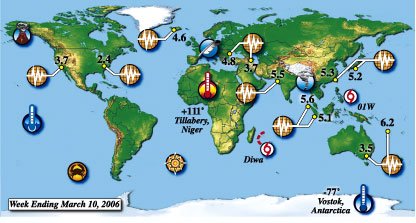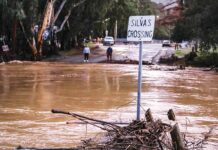La Nina Record
The U.N. World Meteorological Organization (WMO) announced that
unprecedented signs of a strong La Nina ocean cooling have been
observed since early January in the tropical Pacific. The agency
says such an intense and persistent cooling has never been observed
before so early in a year.
By Steve Newman
La Nina Record
The U.N. World Meteorological Organization (WMO) announced that unprecedented signs of a strong La Nina ocean cooling have been observed since early January in the tropical Pacific. The agency says such an intense and persistent cooling has never been observed before so early in a year. La Nina last occurred between mid-1998 and early 2001 and was responsible for dryer weather in the southwestern United States, Florida and western Latin America. Above-average rainfall occurred in Australia, Indonesia, Malaysia and the Philippines during that period. Computer models have predicted the cooling will dissipate over the next three to six months. But the WMO advisory warned that neither a continuation of La Nina beyond mid-year, nor the development of El Nino ocean warming in the second half of 2006, can be ruled out.
Solar Threat
Earth’s power grids, communications and orbiting satellites could be threatened during the next 11-year sunspot cycle, which researchers predict will be 50 percent stronger than the last. Scientists at the U.S. National Center for Atmospheric Research made the forecast based on their measurements of sound waves reverberating inside the sun, and computer projections that used the new data. A sunspot cycle, which begins about every 11 years, peaks with increased solar storms that can eject billions of tons of plasma and charged particles into space. The resulting geomagnetic storms on Earth can slow satellite orbits, disrupt communications and bring down power systems. Solar activity is relatively low at this time, but the next cycle is projected to peak about 2012.
Alaskan Eruption
Alaska’s Mount St. Augustine Volcano produced another in a series of eruptions to the southwest of Anchorage. The Alaska Volcano Observatory reports that the low-level eruption caused a light rain of ash to fall over Cook Inlet. The eruption was accompanied by a brief increase in seismic activity.
Earthquakes
A powerful temblor centered off the South Pacific island nation of Vanuatu was felt strongly on shore, but there were no reports of damage or injuries.
Earth movements were also felt in southeastern Australia, central Japan, Taiwan, southern and northwestern Sumatra, western India, northwestern Iran, eastern Romania, Iceland, North Carolina and the high desert of Southern California.
Tropical Cyclones
High winds from passing Cyclone Diwa knocked out power on the French overseas territory of Reunion. Several roads on the Indian Ocean island were swamped by the storm’s heavy rainfall.
Tropical Storm 01W formed to the south of Yap, but did not sustain storm-force winds long enough to be assigned a name by forecasters.
Bangladesh Twister
A tornado ripping across southwestern Bangladesh killed five people as it flattened hundreds of houses, trees and utility polls in Bagerhat district. Television channel NTV reports about 100 other people were injured and large tracts of crops were destroyed during the 1 1/2-minute whirlwind.
Bird Flu
The deadly H5N1 strain of avian influenza spread farther across West Africa and Western Europe. It was also discovered that cats infected with the strain last month in Austria had managed to rid themselves of the virus. All three felines are still alive, and the Austrian Health and Food Safety Organization says two of them no longer carry the virus. The agency said the cats fought off the bird flu virus as humans often fight off the common cold virus. The discovery in Austria came a week after a dead cat was found with the bird flu virus on the German North Sea island of Ruegen. The H5N1 outbreak has lead to the deaths of hundreds of millions of birds since early 2002 and has killed at least 95 people from Southeast Asia to Turkey.
Yeti Crab
A bizarre species of hairy crustacean was discovered living in hydrothermal vents more than 7,000 feet beneath the South Pacific to the south of Easter Island. Michel Segonzac, of the French Research Institute for Exploitation of the Sea, dubbed his discovery a “yeti crab” even though it is a previously unidentified species of squat lobster. The 10 legs of the 6-inch crustacean are covered entirely with a silky white fur, hence the reference to the elusive Big Foot. It has been given the formal name Kiwa hirsuta, which is derived from Kiwa, the goddess of shellfish in the native Easter Island culture, and hirsute, for hairy. Segonzac says it is the first discovery of a new species in this group since the end of the 19th century.














